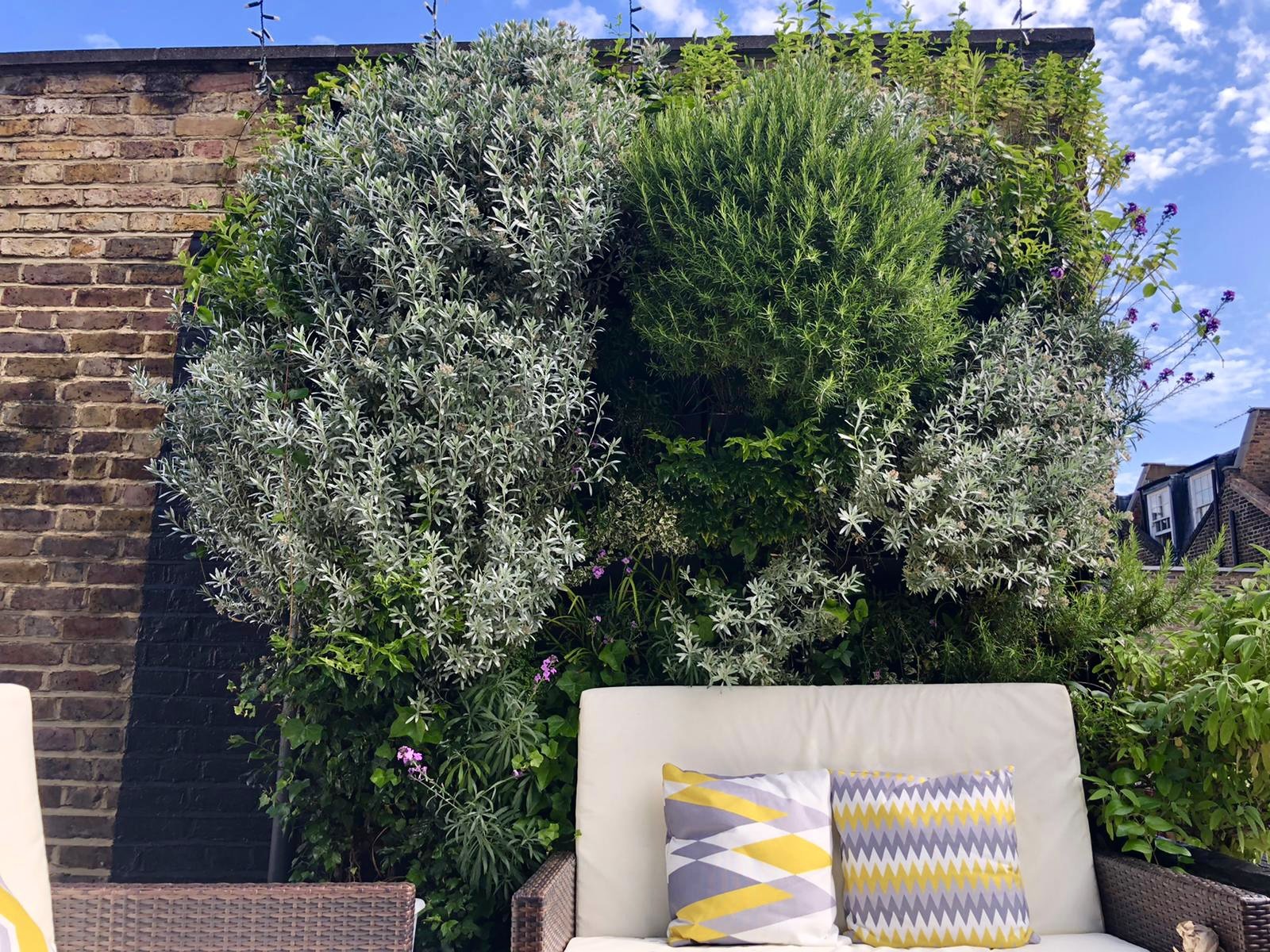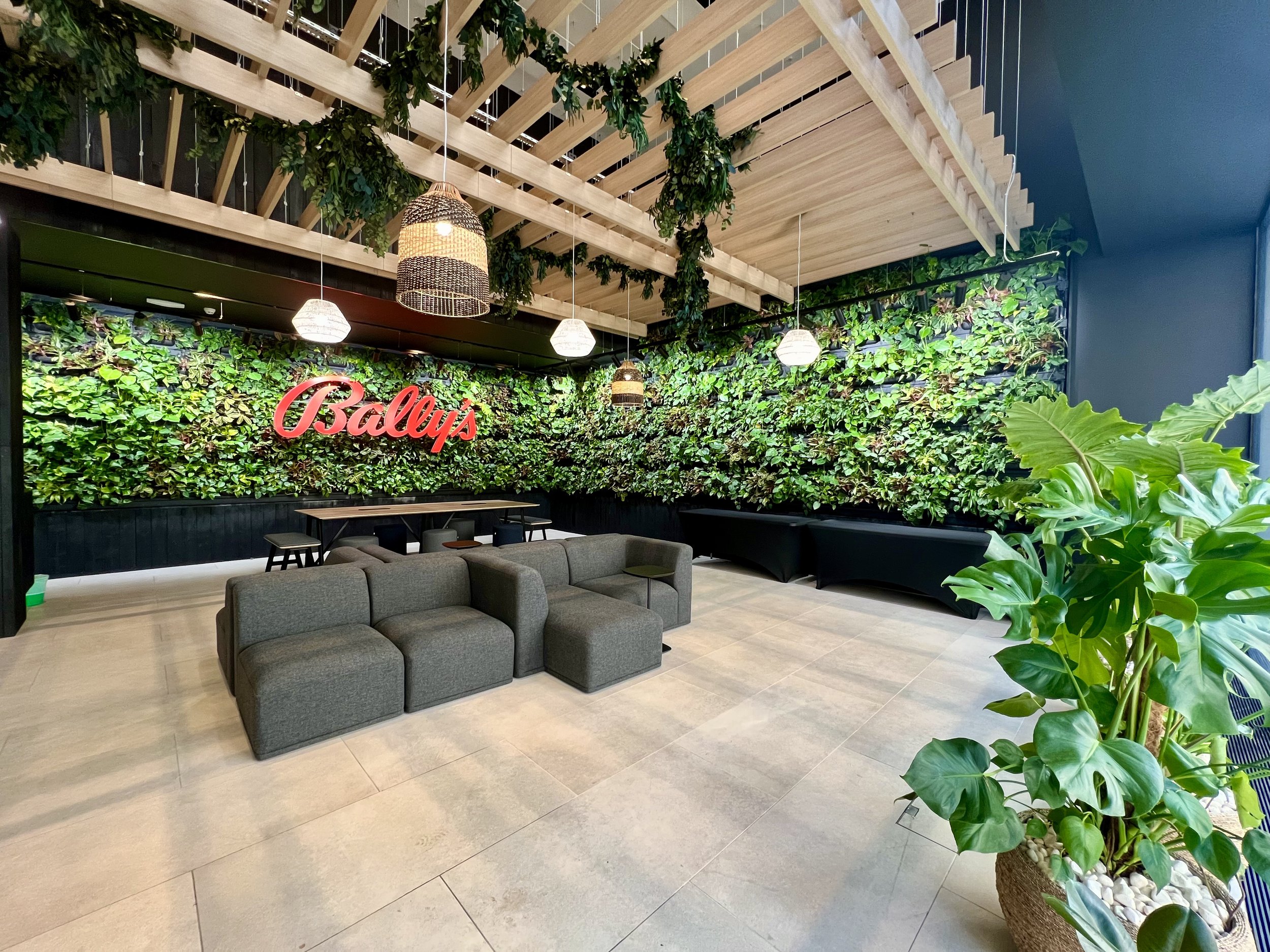Living Walls
Meristem specialises in designing, installing and maintaining living green wall projects for commercial and high-end residential projects throughout the UK.
We are flexible and adaptable to different environments and offer a range of unique and highly innovative living wall systems, including our very popular powder coated steel system that is fully recyclable and is not combustible. We offer robust, affordable living walls that are easy to build and maintain, with an extensive selection of plants to choose from.
What is a living wall?
Living walls, green walls, or plant walls are self-sufficient vertical gardens that are attached to a free-standing frame or to the exterior or interior of a building. With a lack of space and gardens becoming smaller, making use of every surface is a great solution. They differ from green facades (green screens and ivy walls) in that the plants are rooted in a structural support that is attached to the wall itself. The plants receive water and nutrients from within the vertical support rather than from the ground.
"Living green walls are also known as vertical gardens, green walls, living walls, plant walls or ecological walls."
These miraculous structures bring nature back into urban environments. As the concrete jungle expands and pollution increases, the application of living green walls helps reverse this trend. Incorporating carefully chosen plant selections into a cutting-edge design, living green walls are designed to help restore the natural balance. Living green walls can also be one of the elements of your home decor.
Many types of plants will tolerate the high life in a green wall, from herbs and fruit to grasses and ferns. Whether in sun or shade, covering walls with plants can enhance the smallest of spaces.
If you are looking for ideas to brighten up your garden and improve air quality, why not think about adding a vertical garden to your space?
Type of Living Walls: Indoor vs Outdoor
A green wall is a way to bring beauty and nature together inside or outside your home. There are many different ways to design and install green walls. Whether indoor or outdoor, it is essential to think ahead to choose the green wall best suited to your needs. Living walls can be complex to install and maintain, but they offer you many benefits for your health, well-being and the environment.
1.Indoor PLANT Wall
When we think of vertical gardens or green walls, we more easily imagine a building or a big storefront. However, the indoor green wall is often the most popular and the easiest to realise. In addition, plants allow significantly clean the air and improve the thermal and sound insulation. When placed inside your home, the green wall acts as an anti-pollutant. The plants filter out tiny particles and reduce the CO2 level in your home.
2.Outdoor Plant Wall
Outdoor green walls come in many shapes and forms. In addition to their decorative function, they also have environmental benefits, especially in large cities.
The size of outdoor vertical gardens can vary depending on the space. For example, some people prefer an area covered with greenery along the length. Others opt for a vertical wall garden type space. For this reason, green walls are a good solution for any type of open space. They can be used to decorate a terrace or to embellish a view breaker that separates a property from the neighbours!
How to choose plants for your vertical garden?
In any garden design project, it is very important to choose plants that are adapted to the conditions of your garden space (light, temperature, wind, humidity) and capable of growing in a limited space - it is also decisive for the survival of the plants. Also, the indoor plants are completely different from those used for the outdoor walls.
The most important thing to consider when choosing plants to grow in a vertical garden is that they will be plants that will not root too much. Then consider how much sun your garden will get, as well as the temperatures in the area where you live. Select plants that are known for their ease of maintenance, their resistance to drought and for their low nutrient requirements.
Plants
While any plant can theoretically grow for a while in a vertical garden, those that will be able to stay for a long time are plants with small, but strong root systems. It is possible to grow small potted plants, succulents, herbs, vegetables, ferns or all kinds of hanging plants. Flowering plants include orchids, pansies, geraniums, verbena or lavender which will also provide food for pollinators. Vegetables include tomatoes, radishes, peas, cucumbers, chillies and onions.
How do Living walls work?
Living walls are constructed in the same way as real walls. They are built with a skeletal structure that is suspended with sections containing the plants and flowers that will make up the green wall. As for how the green wall itself works, this depends largely on the type of green wall system installed.
Modular systems are the most common type of living wall system. They can be adapted to different sizes and shapes. They can take different forms, from long tray-shaped planters containing multiple plants to individual pocket-sized planters. Freestanding and tray living wall applications include offices, retail stores, and restaurants.
Some green walls have hidden pipes that provide a self-watering mechanism to keep the plants healthy, while others require manual watering.
Living walls contain a large amount of plants in a relatively small, vertical space. By using the walls and extending upward, the plants, which provide maximum benefits, are installed without reducing the floor space.
What are the benefits of living walls?
Green walls have become a new and rising trend in built environments in recent years. Incorporating living nature into urban environments is not only much more attractive but also has a number of other benefits and purposes.
First of all, the visual benefits of green walls cannot be ignored. These eye-catching pieces can make a big impact by decorating an urban environment made of concrete and brick, offering alternatives for urban farming, gardening and interior design.
In addition to the visual and biophilic benefits, living walls can provide natural air purification and humidification through a combination of improved air circulation. Plants naturally absorb carbon dioxide and other pollutants, then release fresh, clean oxygen. Green walls help purify the air by filtering out various allergens from furniture and appliances which can help prevent allergies.
Living walls also help mitigate noise and provide benefits related to biophilic design: the concept that people work better and feel better when they have access to nature in the workplace.
It saves up space. Even if a vertical garden can never replace a real garden, it has the advantage of not taking up any space and is therefore ideal for gardens, roof gardens, balconies or terraces. Although vertical gardens are certainly not limited to small spaces, they are often chosen in these for their ability to maximise indoor or outdoor space efficiently and cleverly. Taking into account space and climatic conditions, imagination is the only limit, it all depends on needs, design and resources. Vertical garden ideas can transform small outside spaces into a lush, green oasis.
Key Benefits of our Living wall systems
✓ Noise attenuation
✓ Recyclable
✓ Air purification
✓ Biophilia benefits - improves well-being
✓ Encourages biodiversity
✓ Extends facade life
✓ Increases value of property
✓ LEED and BREEAM credits
✓ Lowest water consumption
✓ Zintec powder coated steel
✓ Steel system is not combustable
✓ Custom made for any size or shape
✓ Very quick to install, planted off site
✓ Shallow profile, ideal for limited space
✓ Automatic irrigation system
✓ Simple maintenance
✓ Instant impact of foliage
✓ Designed and fabricated in UK
For our technical specification please contact us.
Living Wall Maintenance
To ensure the success and longevity of the wall, green wall maintenance is essential. Like all living plants, green walls must be replaced periodically to compensate for plant loss.
Our living wall maintenance team are experts in plant care, irrigation and living wall systems. We can provide maintenance to your green walls on a one off basis or throughout the year as part of our comprehensive maintenance services.
The maintenance visits will include:
Checking and adjusting irrigation
Pruning, trimming and cleaning where necessary
Removal of weeds and waste
Pest and disease control
Fertilising and feeding
Plant replacement
Live Picture and divider
We also offer a closed system that doesn’t require irrigation or a drain. Our live pictures come in 5 sizes and are perfect for offices and schools, maximising your surroundings using minimal space.
The Live Divider is a 2 sided living wall perfect for dividing up rooms. It creates a more pleasant ambiance, and delivers flexibility in how a room is used. LiveDivider helps create privacy and reduces environmental noise.
Q & A
Can living walls reduce energy costs?
The development of urban environments has caused a disturbing side effect. Metropolitan areas are considerably warmer than rural areas, known as the urban heat island effect. This increase in temperature has a negative impact on the environment, from increased summer energy demand to air pollution and emissions.
Living green walls help offset this problem by providing shade from the effects of direct sunlight. Also, unlike brick or concrete, green surfaces do not store solar energy, but reflect it. Both interior and exterior walls help to actively cool the air in the summer through a process called evapotranspiration, reducing the need to cool the building.
But the benefits of green walls don't stop in the summer. The panels, including the growing medium, insulate the building and also reduce the energy costs associated with heating the building in the winter.
How do living walls help the environment?
Green walls help the environment in the same way that plants do. Plants and plant walls help purify the air. They help reduce noise pollution because they have noise reduction capabilities. They reduce the amount of carbon monoxide in the air and filter pollutants by breathing them in and then exchanging them for clean, fresh, clear oxygen.
How do you water a living wall?
Most green walls are designed with a drip irrigation system, which maximises water usage and is configured with an automated system that schedules irrigation to minimise water waste.
Recirculating systems are the most efficient. They reuse water repeatedly, pumping water from the bottom to the top, until there is no more water. The tank is then refilled.
Direct irrigation is also an option for spaces that do not have room for tanks.
What is the life span of living green walls?
The lifespan of living green walls is difficult to determine with certainty. However, the material, the panels and the substrate, can last up to 25 years. The lifespan of the plants is more difficult to establish. They will continue to live until their roots run out of space and they can no longer grow. It is difficult to give an exact time frame, but plants could potentially grow sustainably in their panels for at least five to ten years before needing to be replaced if the normal maintenance schedule is followed.
If you have a tray system, where plants can be put in and taken out, they will only last about a year and then need to be replaced each season.
Are there any downsides to green walls?
Green walls require regular maintenance. As the plants grow, the soil overflows from the containers. Plants that have outgrown their pots must be replaced.
Indoors, you also have to think about drainage. Without a proper irrigation systems, plants can receive too much water. In such cases, mold can develop, or the plants' roots can rot, killing the plants. Also, if the irrigation (watering) system is not properly installed, the water can damage the wall itself.
Green walls are also expensive to install. However, many experts believe that the benefits outweigh the initial costs.

















